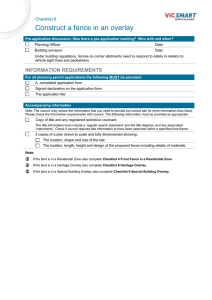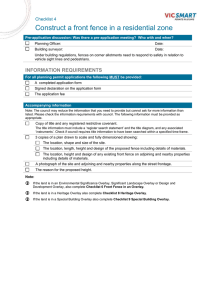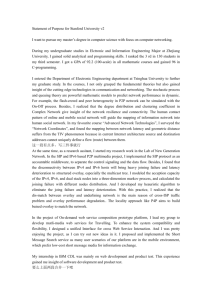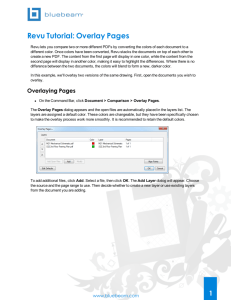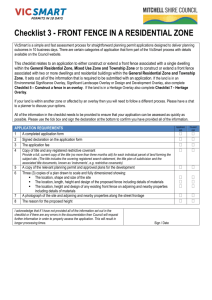Overlay Analysis in 9.2:
advertisement
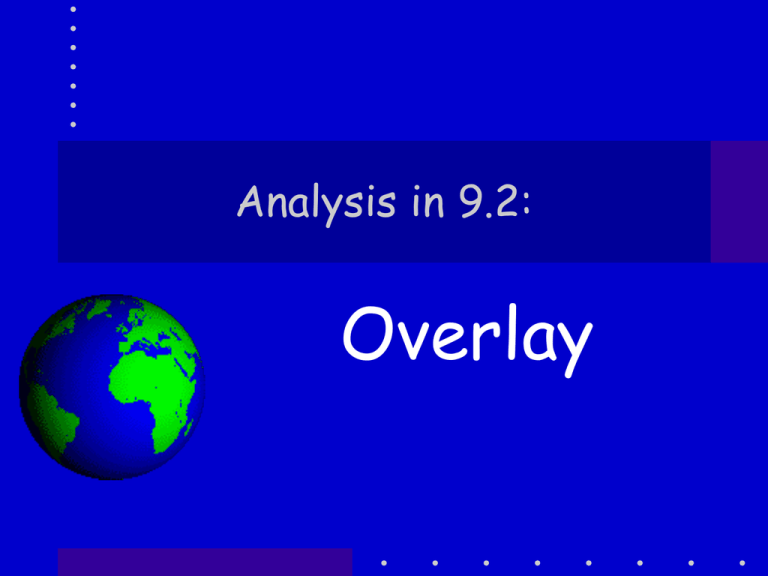
Analysis in 9.2: Overlay Analysis • Usually starts with selection… • Why? • Because – Many steps in analysis are simply selection by • Attribute OR • Location – Most of the OVERLAY functions’ operations work with selected features Here are some actions… • Check that – Layer(s) are the ones you want – The selection options are what you want • Check the bottom of the dialog and make sure it is doing what you want it to • That sounds easy but quite often NOT easy • Here are some of the options Options: Intersect Options:Touch Bndy of… Options: Have their Center in… Options: Are completely w/in… Options: w/in a distance of… Options: are contained by… Selection Summary • Allow the selection of features based on criteria • Is a pretty rich set of operations • BUT – Some share name with the REAL overlay operations but don’t deliver the same result • • • • • • • • • • • Intersect Within distance of Completely contain Completely within Have center in Share segment w/ Touch boundary of Are identical to Are crossed by outline Contain Are contained by Overlay Operations • Overlay operations are like the “select by location” functions but not exactly the same. • Both use two layers – Select by location just selects features in one of the layers – Overlay operations create new feature classes Toolbox Overlay: Erase • From Help: Erase feature removes a chunk of the input feature • It is important to keep Input and Erase feature correct or GIGO Overlay: Union • This computes a geometric intersection of the input and output feature classes . ALL features will be written to the output feature class with the attributes from both. • Or: This tool builds a new feature class by combining the features and attributes of each feature class. Overlay: Union UNION: another view Overlay: Identity • Computes a geometric intersection (logic) of the input and identity features • Input features (or portions thereof) that overlap the identity features will get their attribute features from the identity features • To put it another way: combines the portions of features that overlap the identity features to create a new feature class. Overlay: Identity • Computes a geometric intersection (logic) of the input and identity features Clips by the Input • Input features (or portions thereof) that feature and then overlap the identity features will get UNIONS what is attribute features from the identity left. features • To put it another way: combines the portions of features that overlap the identity features to create a new feature class. Overlay: Intersect • Computes the geometric intersection of the input features or portions of features COMMON to all layers. • This tool builds a new feature class from the intersecting features common in both feature classes. Available with any ArcGIS license. Overlay: Intersect • Computes the geometric intersection of the input features or portions of features COMMON to all layers. Intersect is NOT • This tool buildsthe a new class same feature as from the intersecting Identityfeatures common in both feature classes. Available with any ArcGIS license. Overlay: Symmetric Diff • Computes a geometric intersection of the input and update features. Any features COMMON to ONLY one of the inputs will be written to the output • Or to put it another way: This tool creates a feature class from those features or portions of features that are not common to any of the other inputs. Overlay: Symmetric Diff This is the olive drab • Computes a geometric intersection of the feature showing through input and update features. a hole inAny thefeatures yellow COMMON to ONLY one offeature the inputs will ! be written to the output • Or to put it another way: This tool creates a feature class from those features or portions of features that are not common to any of the other inputs. Overlay: Update • Computes the geometric intersection of the input and update features. The attributes and geometry of the input features are replaced by the update features. • This tool updates the attributes and geometry of an input feature class or layer by the Update feature class or layer that they overlap Overlay: Update • Computes the geometric intersection of the input and update features. The attributes and geometry of the input features are replaced by the update features. • This tool updates the attributes and geometry of an input feature class or layer by the Update feature class or layer that they overlap Overlay: Summary IDENTITY INTERSECT SYM-DIF UNION UPDATE Buffer • Buffering is an additional tool used in Not Analysis. Dissolved Dissolved = All Summary • The analysis tool in ArcGIS are very powerful • And fairly easy to understand … one at a time! • It is use by combining the overlay and selection tools to solve a problem that is the problem! A Problem • Find location for a laboratory – – – – – Within 300 meters of a sewer line NOT within 200 meters of a stream Parcel in a specific landuse (900 is forest) Not on steep slopes (<=20%) >=100 acres but less than 200 acres • THIS IS A CLASSIC LOCATION PROBLEM Sewers w/in 300m Buffer Sewbuf 300 Sewer OK ERASE Streams not w/in 20m Buffer Landuse: Lucode =? Query Slope<=20% Strmbuf 20 IDENTITY IDENTITY Query Of selected polys Land OK OK sites Booby Trap • Select by location using Intersect does not give the same results as Overlay Intersect Sel by Location: Intersection • Intersected Parcels w/ Cover with Ag Selected • The red outlines are the selected parcels Lets Zoom In ---- Select by location • You can see that • Entire Parcels were selected • Including… • Parcels with only a little bit of Ag landuse were selected Overlay Intersection • BUT THE RESULT IS VERY DIFFERENT! Red outlines are the parcels selected by Select by theme Green are the result of the Overlay Comparison So you have to be careful! • Exercises 7a and 7 b have you experiment with some simple layers • And I will be throwing some relatively simple problems your way to provide more practice • And I will be changing the schedule at bit too (what else is new?).

